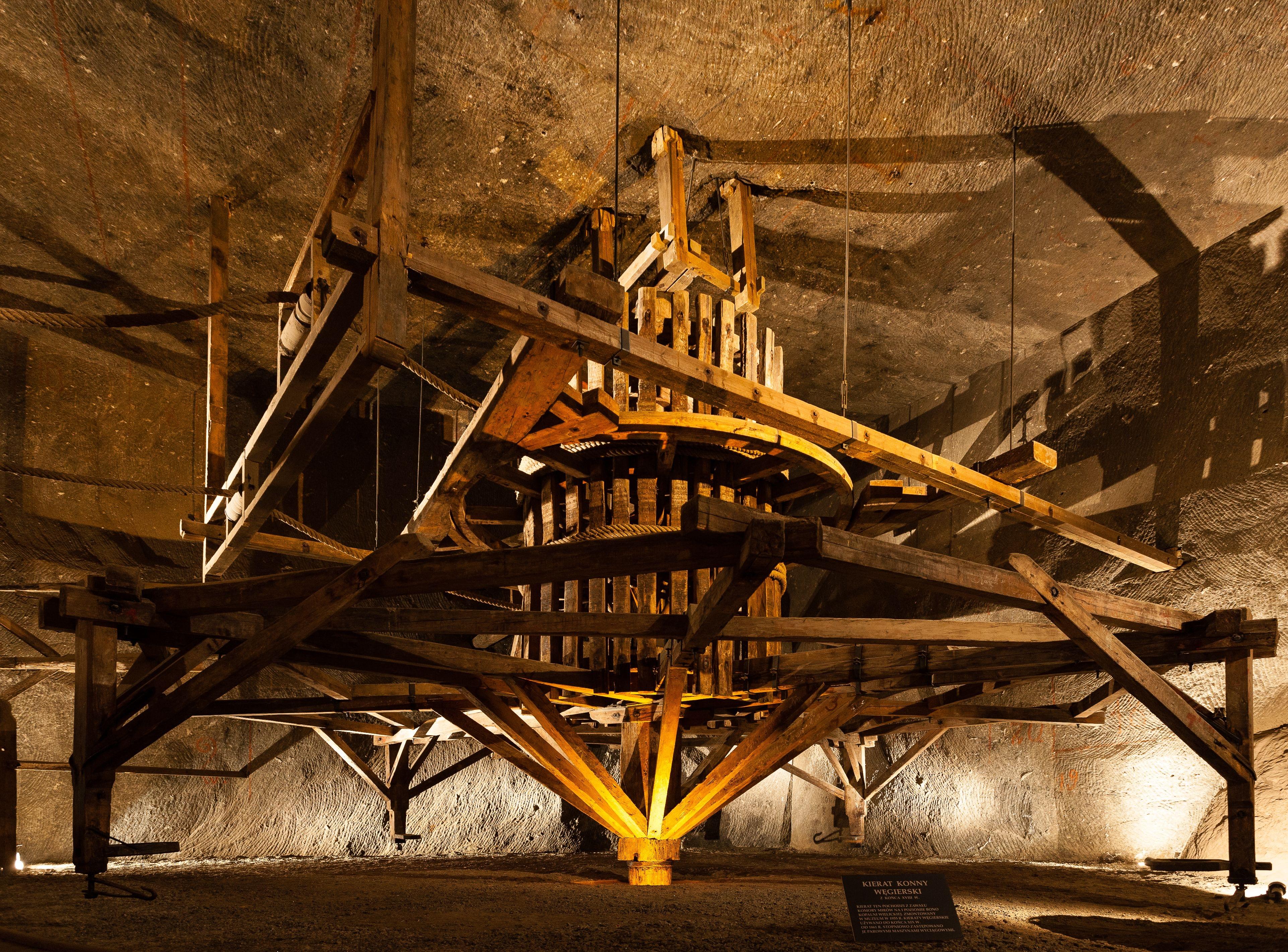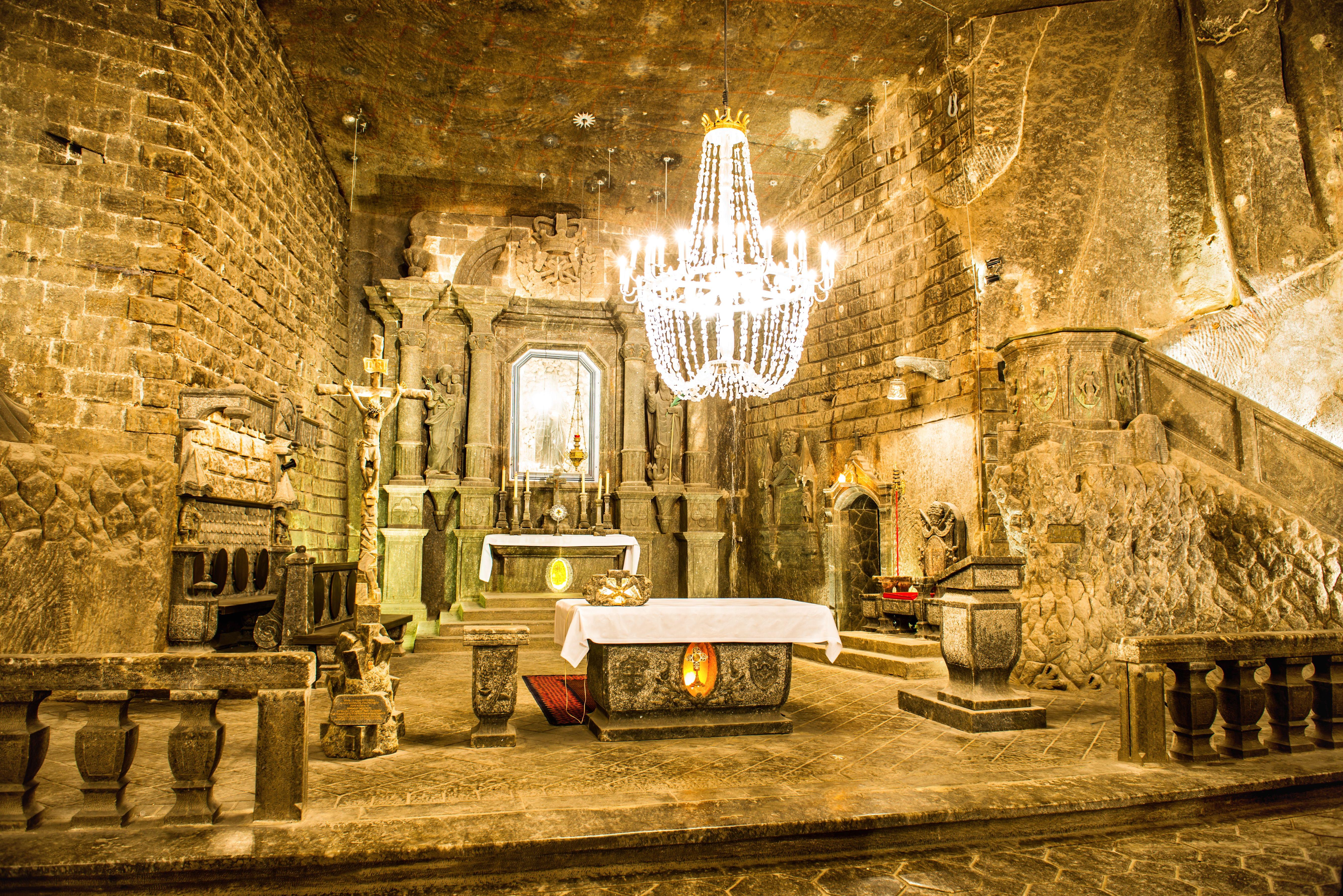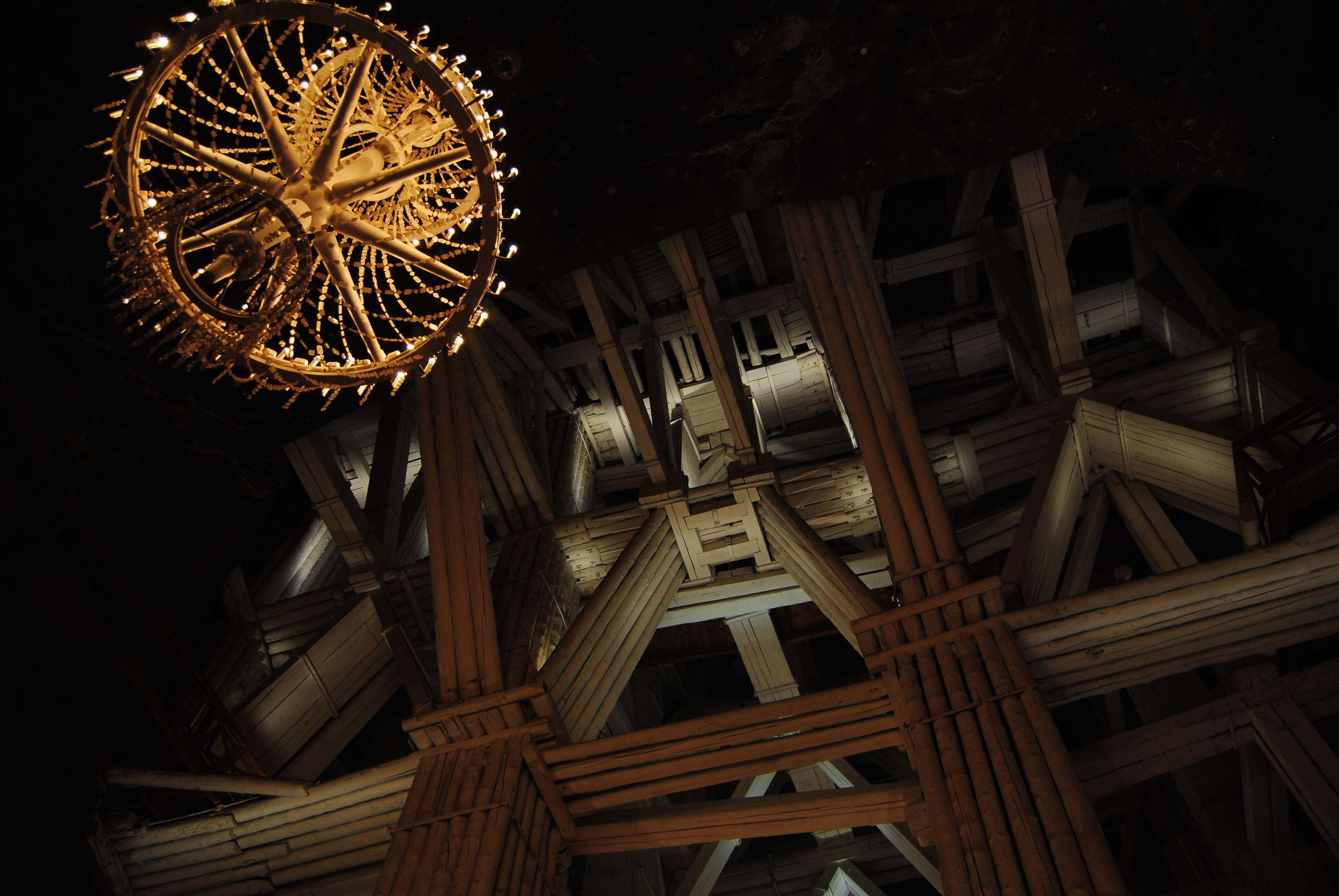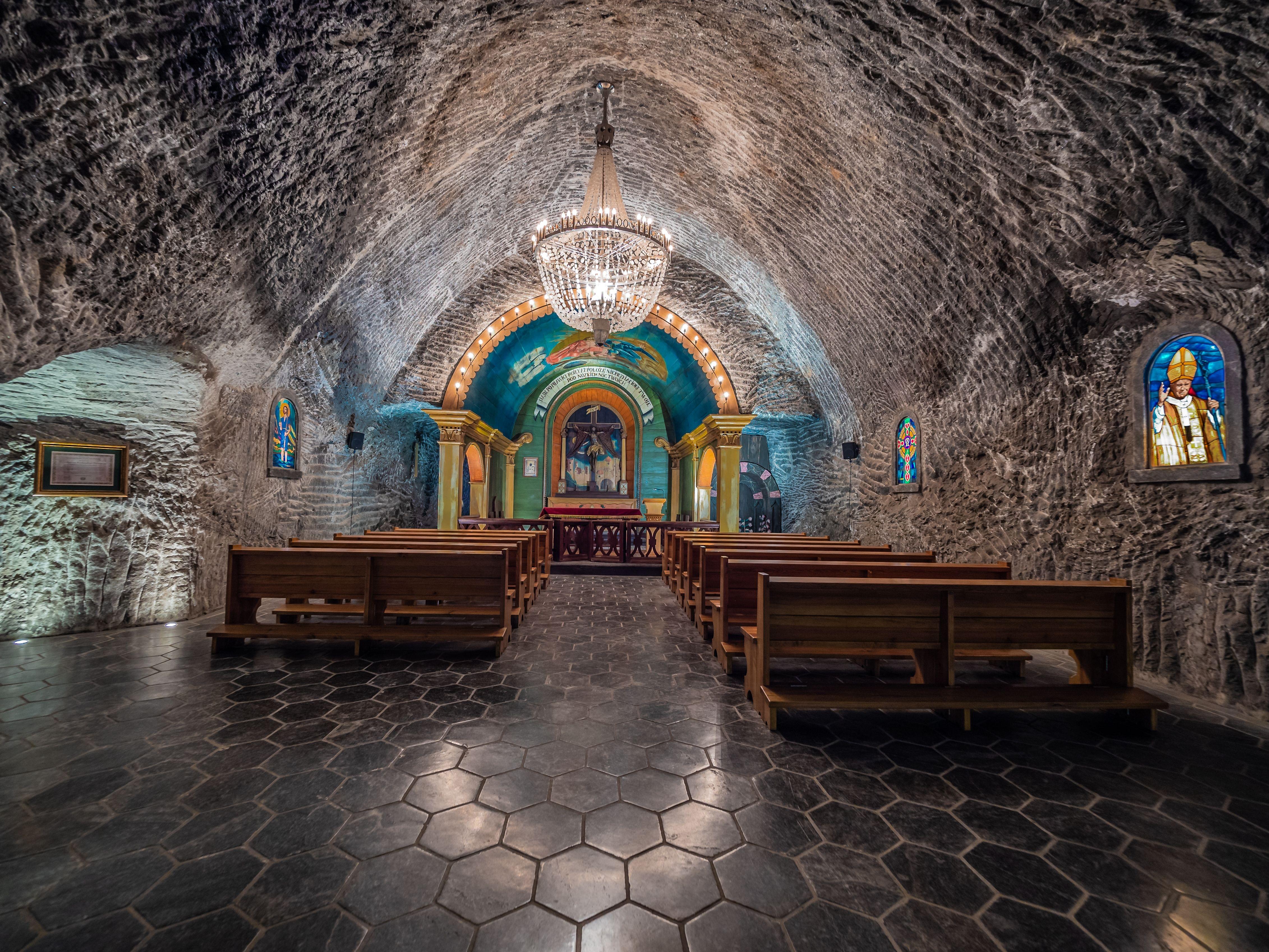About Wieliczka Salt Mine
History of Wieliczka Salt Mine
Brine from salt water springs was boiled in clay pots to extract pure salt during Neolithic times. Old saltworking tools discovered in Barycz village in Central Europe near Wieliczka belong to the prehistoric period. The salt extracted was used as a preservative for meat and it later became a means of payment in trade to those who did not own this valuable substance. This secret of salt production by evaporation was passed on to the next generations in the following centuries.
During the 11th and 12th centuries, when salt water springs began to disappear, the search for brine started. Wells were constructed and saline water was brought to the surface after which it was boiled in pans to get pure evaporated salt. In the 13th century, lumps of rock salt were found for the first time while digging wells which instigated the idea of obtaining salt by mining. The first mining was done in the second half of the 13th century by local specialists with technical knowledge from Western Europe.
During this period, the revenue from salt extraction played a crucial part in the wealth of the nation’s treasury. Casimir III, who was the Polish king then, founded the Krakow Academy and Saltworks Statue from the high profits of salt mining. Around 350 people worked in Wieliczka Salt Mine Poland and the annual production of salt was 7000-8000 tonnes then. However, mining was still seasonal and was done only when agricultural works were not carried out. Visitors were allowed to enter the mine and Nicolaus Copernicus was the first tourist in 1493.
The period from the 16th to 18th centuries marked a dynamic development in the mining of rock salt as it was when the Wieliczka Salt Mine Poland moved to a year-round working pattern. Specialists from various fields were recruited and the first maps of the underground were created. The search for salt extended below the first level and by the 17th century it went till the third level. By 1724, extraction of salt by evaporation was stopped and only the mining methods were used. The number of visitors to the mine also grew steadily during this period.
In 1772, the partition of Poland took place and Wieliczka Salt Mine Poland came under the control of the Habsburg Monarchy. The new owners focused on the development of the mine but did not care for its security. Extraction of salt by gunpowder was formulated and hence production resumed in modern saltworks. Tourism was given importance and different attractions like devil’s drop, horse-drawn railway and boat rides on saline lakes were initiated to attract visitors. The number of tourists grew up to a hundred people per week by the start of the 20th century.
After World War I and repossession of independence by Poland, the Wieliczka Salt Mine came under the Polish administration. The names of excavations and shafts were symbolically changed during this time. Production of salt increased to 203,000 tonnes per year and trade became highly profitable. The mine became stabilised with further developments, expansion and tourist growth during the Interwar Period. Eminent personalities were invited to the mine and events were held for visitors to lure many tourists into coming here often.
Right before the start of World War II, a leaching process in which brine was obtained dissolving salt rocks with fresh water was discovered. The 1940s and 1950s were quite difficult for the Wieliczka Salt Mine Poland since there was an increase in production regardless of the cost and safety of the workers. The mine extended to nine levels but the idea of preserving the mine for future generations rather than industrial production came into existence. By 1978, mining techniques were stopped and production of salt by evaporation using wet mining commenced.
The mine, at present, has no live extraction but around 400 miners work here every day for safety reasons. They toil hard to preserve the mine for tourists by filling the post-excavation voids with brine and taking care of fresh water leaks. New attractions are put up in the underground mine while the existing chambers, corridors and chapels are renovated. The Wieliczka Salt Mine Poland has now become a famous tourist attraction that welcomes nearly 2 million visitors every year. It is a UNESCO World Heritage Site and an official National Historic Landmark of Poland.
Explore The Mines
Endless Corridors : Wieliczka Salt Mine Poland is a complex labyrinth with endless corridors that are spread across nine levels. The underground galleries and corridors of the mine run for 245 kilometres in length and are located at a depth of 327 kilometres. However, only 2% of the underground passages are alone open to the public for visit.
Crystal Grottoes : The Crystal Caves, first discovered in 1860, are made up of Halite crystals and are located at a depth of 70 to 114 metres. These caverns with huge, long and pure rock salt crystals are currently inanimate nature reserves in Poland. Access to the caves is prohibited except for scientific and teaching purposes.
Chambers : Chambers of different sizes, shapes and characters are built on the sites where salt was extracted. There are nearly 2500 chambers but no two of them are identical. Some famous chambers of the mine are Michalowice Chamber, Weimar Chamber, Pieskowa Skala Chamber, St Anthony’s Chapel and St Kinga’s Chapel.
Mining sites : About 400 miners work daily in the Wieliczka Salt Mine in Poland for safety work. They fill the post-excavation voids with a mixture of sand and brine and also look for water leaks to protect the mine from fresh water effects. New attractions are put up for visitors along with Miner’s Route and Tourist Route for sightseeing.
Saltworks : Mining of rock salt was discontinued in Wieliczka Salt Mine Poland in 1996 but salt is still produced from the brine. The fresh water that dissolves the rock salt is sent to the Salt Water Disposal Facility, commonly known as ‘Saltworks’, on the surface. The salt water is heated and evaporated under low pressure to get pure evaporated salt.
Pithead Waiting Room : Pithead Waiting Room is the miners’ cloakroom that is found in the buildings on the surface of the Mine near St Kinga’s Shaft. Their clothes are found hanging from the ceiling from a height of 6 metres on hooks and chains. A briefing for the miners is conducted every morning at the Pithead Waiting Room.
Lamp Room : A Lamp Room in the Wieliczka Salt Mine Poland is where the miner’s pit token, lamp and carbon monoxide absorber are kept. There are two Lamp Rooms in the mine; one is for the miners while the other is for tourists who go on the Mining Route.
Geology of Wieliczka Salt Mine
Around 13.6 million years ago, the cooling of climate, rock mass movements and subsidence caused the seabed of Miocene Sea to drop steadily. This created a reservoir with very high salinity in the Carpathian Foredeep as a result of which salt deposits were formed in the Wieliczka Salt Mine Poland. Slow precipitation of salt deposit along with caving in of seabed and erosion of coastal parts caused excessive deposit of gangue in the salt beds. These salt deposits extend for 300 km in length and 100 km in width which includes Wieliczka deposits that run for 10 km in length and 1.5 km in width.
The Wieliczka Salt Mine Poland has an exclusive geological structure that cannot be found anywhere else in the world. The tectonic activity of the Carpathian Mountains caused folding of the salt layers and shaped the deposit into an unusual structure. The two-fold composition of the deposit has two parts namely, upper lump deposit and lower bedded deposit. The lump deposit is made up of chunks of rock salt while the bedded deposit has different types of salt layers like fore-shaft salt deposit and eagle spiza salt.
Rock salt or halite that appears green due to the admixture of claystones is the commonly found salt in Wieliczka Salt Mine Poland. There are different types of Wieliczka salt which are easily identifiable for experienced miners but are difficult for tourists. You can witness the Typical green salt and stained-glass green salt in the lump deposit and fore-shaft salt in the bedded deposit. You can also see the different types of Spiza salt like Eagle spiza salt and the rare Cracking salt in the bedded deposit.
The underground landscape of Wieliczka Salt Mine in Poland is even more beautiful because of various forms of Secondary crystallisation salts. As you walk along the sightseeing route, you can see different structures of salts from geological times to modern times. The crystallisation is associated with brine leaks and hence depending on the location of the leak, it can take a variety of forms. You can see spongy growths of salt called ‘salt cauliflowers’, narrow dripstone tubes known as ‘salt pasta’ and the less common salt stains and stalagmites.
Know Before You Visit Wieliczka Salt Mine
Essential Information :
Location: Daniłowicza 10, 32-020 Wieliczka, Poland
Timings: 8:30 AM – 5:30 PM on all days of the week
Best Time To Visit :
The best time to visit Wieliczka Salt Mine in Poland is during the spring season from March to May or during the autumn months of September to November as the weather is pleasant and favorable for exploring the mine. Since the mine gets colder during winter, it is better to visit the mine during summer, spring or autumn.
How To Reach :
By Train: Board a train at Krakow Glowny Station and a light at Wieliczka Rynek Kopalnia station from where the mine is just 500 metres away.
By Bus: Take the bus on line 304 from Dworzec Główny Zachód stop to Wieliczka Kopalnia Soli stop from where you can walk to the mine entrance in a few minutes.
FAQs
What is special about the Wieliczka Salt Mine?
Wieliczka Salt Mine in Poland is the oldest mine of its kind in Europe and boasts of housing 327 kilometres of tunnels spread over nine levels. The underground chapels adorned with church iconography, statues sculpted in salt and art galleries are the eye-catchy highlights of the Wieliczka Salt Mine Poland. Chapel of St. Kinga, which is located 101 metres below the Earth’s surface, is the world’s biggest church built underground.
Can I book Wieliczka Salt Mine tickets online?
Yes, you can book tickets to Wieliczka Salt Mine Poland online while enjoying the comfort of your home rather than waiting in long queues at the entrance of the mine. You can select the date and time of your visit as per convenience depending on the availability of the tickets.
What is the best time to explore Wieliczka Salt Mine?
The best time to explore Wieliczka SaltMine Poland is during early in the morning when the mine has just opened considering how long the tour around the mine takes.
Why is the Wieliczka Salt Mine important?
The Wieliczka Salt Mine in Poland holds such a significance that it has helped shape the legacy of the Krakow region and the people who reside there. The discovery of rock salt was a huge development for the kingdom of Poland since it helped stabilize the economy of the country. The salt mine operated incessantly for 700 years and produced table salt continuously until 2007. It is a portrayal of the growth in mining techniques of Europe from the 13th to the 20th century.
Do we have to buy a separate ticket for kids before visiting Wieliczka Salt Mine?
Children below 4 years of age are allowed to enter the Wieliczka Salt Mine in Poland for free. However, other visitors are not allowed without the tickets.



